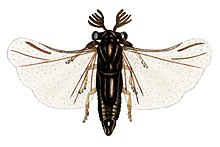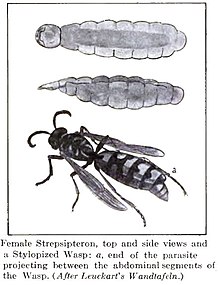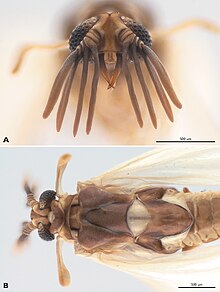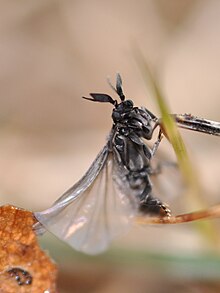Strepsiptera
| Strepsiptera Temporal range:
Middle Cretaceous - recent | |
|---|---|

| |
| Male | |

| |
| Stylopid female | |
| Scientific classification | |
| Domain: | Eukaryota |
| Kingdom: | Animalia |
| Phylum: | Arthropoda |
| Class: | Insecta |
| (unranked): | Holometabola |
| Clade: | Aparaglossata |
| Clade: | Neuropteroidea
|
| Clade: | Coleopterida |
| Order: | Strepsiptera Kirby, 1813 |
| Families | |
| |
The Strepsiptera (
The order is not well known to non-specialists, and the nearest they have to a common name is stylops, in reference to the genus Stylops.[3] The name of the order translates to "twisted wing", giving rise to other common names used for the order, twisted-wing insects and twisted-winged parasites.[4]
Adult males are rarely observed, although specimens may be lured using cages containing virgin females. Nocturnal specimens can also be collected at light traps.[1]
Biology
Appearance and structure
Males
Males of the Strepsiptera have wings, legs, eyes, and antennae, though their mouthparts cannot be used for feeding. Many have mouthparts modified into sensory structures. To the uninitiated the males superficially look like flies.[1] The forewings are modified into small club-shaped structures called halteres, which sense gyroscopic information.[5] A similar organ exists in flies, though in that group the hindwings are modified instead, and the two groups are thought to have independently evolved the structures.[6] The hindwings are generally fan-shaped, and have strongly reduced venation. The antennae are flabellate, and are covered in specialised chemoreceptors, likely to detect females over long distances.[7]
Adult male Strepsiptera have eyes unlike those of any other
Females
The females of Stylopidia, which includes 97% of all described strepsipteran species and all modern strepsipteran families except
Larvae
Newly hatched primary (first instar) larvae are on average 230 micrometres (0.0091 in) in length, smaller than many single-celled organisms. They are highly mobile with well developed stemmata, which are able to distinguish color. The underside of the body is covered in minute hair-like structures (microtrichia), which allow the larvae to stick to wet surfaces via capillary action. At the back of the body are well developed large bristle-like cerci, which are attached to muscles, which allow the larvae to jump. The tarsal segment of their legs have structures which allow them to cling to their hosts. Later larval instars which develop inside the host are completely immobile.[7]
-
Free living female of Mengenilla moldrzyki (Mengenillidae)
-
Male pupa head (top left) and adult female of Xenos yangi (Stylopidia, Xenidae) in ventral view (right) and closeup of the cephalothorax (centre and bottom left)
-
Recently hatched larvae of a stylopid strepsipteran on the bee Andrena nivalis
-
Closeup of the head of male Xenos peckii
-
Adult male strepsipteran in dorsal view, halteres highlighted with red arrows
Life cycle
In the Stylopidia, the female's anterior region protrudes out between the segments of the hosts abdomen. In all strepsipterans the male mates by rupturing the female's
Strepsiptera eggs hatch inside the female, and the
Larvae have legs and actively seek out new hosts. Their legs are partly vestigial in that they lack a
Once inside the host, they undergo
Parasitism
Strepsiptera of various species have been documented to attack hosts in many orders, including members of the orders
Very rarely, multiple females may live within a single stylopized host; multiple males within a single host are somewhat more common.[1]
Strepsiptera of the family Myrmecolacidae can influence their host's behaviour, causing their ant hosts to linger on the tips of grass leaves, increasing the chance of being found by strepsipteran males (in the case of females) and putting them in a good position for male emergence (in the case of males).[19]
Taxonomy

The order, named by

Strepsiptera were once believed to be the sister group to the beetle families


Families

The vast majority of living strepispterans are placed within the grouping Stylopidia, which includes the families
The Stylopidae have four-segmented tarsi and four- to six-segmented antennae, with the third segment having a lateral process. The family Stylopidae may be
Strepsipteran insects in the genus Xenos parasitize Polistes carnifex, a species of social wasps.[29] These obligate parasites infect the developing wasp larvae in the nest and are present within the abdomens of female wasps when they hatch out. Here they remain until they thrust through the cuticle and pupate (males) or release infective first-instar larvae onto flowers (females). These larvae are transported back to their nests by foraging wasps.[30]
Cladogram
After:[2]
| Strepsiptera |
| ||||||||||||||||||||||||||||||||||||||||||||||||||||||||||||||||||||||||
Relationship with humans
Some insects which have been considered
See also
- Entomophagous parasite
References
- ^ a b c d e f g h i j k l m n Whiting, M. F (2003). "Strepsiptera". In Resh, V. H.; R. T. Cardé (eds.). Encyclopedia of Insects. Academic Press. pp. 1094–1096.
- ^ PMID 34478185.
- ^ Merriam-Webster: stylops broadly: an insect of the order Strepsiptera |[1]
- ^ Pierce, W. Dwight (1909). A monographic revision of the twisted winged insects comprising the order Strepsiptera Kirby. Washington: US Government.
- S2CID 43790345.
- PMID 11050348.
- ^ PMID 18356032.
- S2CID 21888897.
- ^ PMID 32719048.
- S2CID 84185553.
- ^ PMID 27125507.
- ^ Greenwood Press.
- ^ a b c d e Borror, D.J.; Triplehorn, C.A.; Johnson, N.F. (1989). Introduction to the Study of Insects (6 ed.). Brooks Cole.
- PMID 11703867.
- PMID 12788973.
- ^ Beani, Laura (2006). "Crazy wasps: when parasites manipulate the Polistes phenotype" (PDF). Annales Zoologici Fennici. 43: 564–574.
- S2CID 83484969.
- ^ .
- JSTOR 3494966.
- ^ Pierce, William Dwight (1909). A monographic revision of the twisted winged insects comprising the order Strepsiptera Kirby. Government Printing Office. pp. 209.
- ^ Kathirithamby, Jeyaraney (2002). "Strepsiptera". The Tree of Life Web Project. Archived from the original on July 15, 2017.
- PMID 12064233.
- ^ PMID 11975347.
- S2CID 25178911.
- PMID 12066692.
- S2CID 92390950.
- S2CID 85232914.
- S2CID 83936131.
- .
- S2CID 9691419.
- ISBN 978-9400722194.
Further reading
- ISBN 0-521-82149-5.)
{{cite book}}: CS1 maint: multiple names: authors list (link
External links
- Strepsiptera in Baltic amber (www.amber-inclusions.dk) - Strepsiptera, Mengeidae, Mengea tertiaria
- Strepsiptera - Tree of Life Web Project
- Survey of Modern Counterparts of Schizochroal Trilobite Eyes: Structural and Functional Similarities and Differences Archived 2007-09-28 at the Wayback Machine
- Family outline: Strepsiptera
- The Peculiar Strepsiptera Life Cycle
- Strepsiptera discussed in RNZ Critter of the Week, 30 August 2022






